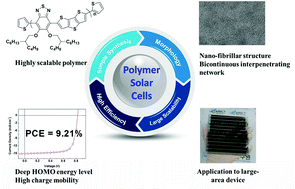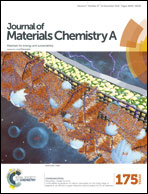Achieving a solar power conversion efficiency exceeding 9% by modifying the structure of a simple, inexpensive and highly scalable polymer†
Abstract
We report a systematic study of the role of introduced alkyl chains in the easily synthesized conjugated PDTT-ROBT copolymers, which consist of dithieno[3,2-b:2′,3′-d]thiophene (DTT) and alkoxy substituted benzothiadiazole (ROBT) subunits. We synthesized new conjugated polymers PDTT-BOBT and PDTT-HDBT, which have molecular structures similar to those of the previously reported PDTTDABT polymer, but have modified alkyl chains in the polymer backbone. The modifications of the alkyl chains from linear (PDTTDABT) to branched (PDTT-BOBT and PDTT-HDBT) had prominent effects on the solubility, crystallinity, molecular orientation and morphology of the co-polymers. Solar cell devices containing the new PDTT-BOBT and PDTT-HDBT polymers exhibited power conversion efficiency (PCE) values of 9.2% and 6.2%, respectively, considerably greater than the 2.2% PCE of the previously reported PDTTDABT polymer, and the 9.2% PCE is in fact the highest to date for donor–acceptor polymers containing the BTOR acceptor. This high PCE may be explained by the well-aligned energy levels, optimum film morphology with bicontinuous interpenetrating networks, enhanced charge carrier mobility and decreased amount of charge recombination that we observed for PDTT-BOBT, in contrast to those exhibited by PDTTDABT and PDTT-HDBT. Considering the potential of PDTT-BOBT for industrial application, we tested the scalability, large-area devices (6600 mm2) and stability of PDTT-BOBT. As a result, the PDTT-BOBT polymer with its easily synthesized structure and high efficiency has considerable potential for being synthesized on a large scale and for use in printable electronic applications.



 Please wait while we load your content...
Please wait while we load your content...